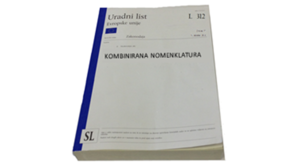Nomenclature, classification of goods and TARIC
News
Topic description
General

Goods subject to trade must be classified in the Combined Nomenclature in order to receive adequate treatment. Application of correct measures (the rate of customs duty, non-tariff measures, determination of origin) to goods placed under a customs procedure depends on their classification in the customs nomenclature.
The Common Customs Tariff of the European Union is based on the international Nomenclature of the Harmonised System and the Combined Nomenclature of the EU. The latter integrates the nomenclature (a detailed list of goods) and the applicable rates of duty. The customs tariff comprises the entire legislation of the EU which affects the rates of the customs duty. The Harmonised System is an international multi-purpose nomenclature which was elaborated under the auspices of the World Customs Organisation (WCO). The international Nomenclature of the Harmonised System (HS) is governed by the international Convention on the Harmonised Commodity Description and Coding System.
The Combined Nomenclature of the EU comprises additional 8-digit subdivisions of goods.
Classifying goods in the Customs Tariff means that goods are classified under the specific subheading of the Combined Nomenclature or under the TARIC code according to the applicable provisions. TARIC is the integrated Tariff of the EU and a database which integrates all measures relating to the EU customs tariff, commercial and agricultural legislation. The TARIC nomenclature comprises additional 10-digit TARIC subdivisions of goods.
The customs authorities can decide on the classification of certain goods in the Nomenclature of the Customs Tariff by issuing a written decision, the so-called Binding Tariff Information (BTI).
Treatment of goods in customs procedures as well as in other procedures depends on the correct classification of goods in the customs tariff, which is also the basis for the application of correct customs duties, anti-dumping duties, quotas, waivers, VAT, agricultural subsidies etc.
Details
Legislation
Agreements, convetions & protocols
EU legislation
Regulations
- Regulation (EU) No 952/2013 of the European Parliament and of the Council of 9 October 2013 laying down the Union Customs Code
- Commission implementing Regulation (EU) 2015/2447 of 24 November 2015 laying down detailed rules for implementing certain provisions of Regulation (EU) No 952/2013 of the European Parliament and of the Council laying down the Union Customs Code
- Commission Delegated Regulation (EU) 2015/2446 of 28 July 2015 supplementing Regulation (EU) No 952/2013 of the European Parliament and of the Council as regards detailed rules concerning certain provisions of the Union Customs Code
- Commission Delegated Regulation (EU) 2016/341 of 17 December 2015 supplementing Regulation (EU) No 952/2013 of the European Parliament and of the Council as regards transitional rules for certain provisions of the Union Customs Code where the relevant electronic systems are not yet operational and amending Delegated Regulation (EU) 2015/2446
- Commission Implementing Decision (EU) 2016/578 of 11 April 2016 establishing the Work Programme relating to the development and deployment of the electronic systems provided for in the Union Customs Code
- Council Regulation (EEC) No 2658/87 of 23 July 1987on the tariff and statistical nomenclature and on the Common Customs Tariff
- Commission Implementing Regulation (EU) 2018/1602 of 11 October 2018 amending Annex I to Council Regulation (EEC) No 2658/87 on the tariff and statistical nomenclature and on the Common Customs Tariff (OJ L 273/2018, 31.10.2018)
- Commission Implementing Regulation (EU) 2019/1776 of 9 October 2019 amending Annex I to Council Regulation (EEC) No 2658/87 on the tariff and statistical nomenclature and on the Common Customs Tariff (OJ L 280/2019, 31.10.2019)
- Commission Implementing Regulation (EU) 2020/1577 of 21 September 2020 amending Annex I to Council Regulation (EEC) No 2658/87 on the tariff and statistical nomenclature and on the Common Customs Tariff (OJ L 361/2020, 30.10.2020)
- Commission Implementing Regulation (EU) 2020/2159 of 16 December 2020 amending Annex I to Council Regulation (EEC) No 2658/87 on the tariff and statistical nomenclature and on the Common Customs Tariff (OJ L 431/2020, 21. 12. 2020) (Amendment of CN 2021 with Covid-19 related products)
- Commission Implementing Regulation (EU) 2021/1832 of 12 October 2021 amending Annex I to Council Regulation (EEC) No 2658/87 on the tariff and statistical nomenclature and on the Common Customs Tariff
- Commission Implementing Regulation (EU) 2022/1998 of 20 September 2022 amending Annex I to Council Regulation (EEC) No 2658/87 on the tariff and statistical nomenclature and on the Common Customs Tariff
- A list of EU regulations on the classification of goods SI
Related regulations
- Amendment of CN EN in 2022
- Amendment of CN EN in 2021
- Amendment of CN EN in 2020
- Amendment of CN EN in 2019
- Explanatory notes to the Combined Nomenclature of the European Union (OJ C 119/2019, 29.3.2019)
- Code of conduct for the management of the Combined Nomenclature
- Guidelines on the classification in the Combined Nomenclature of goods put up in sets for retail sale
- List of customs authorities designated by Member States for the purposes of receiving applications for, or issuing Binding Tariff Information



